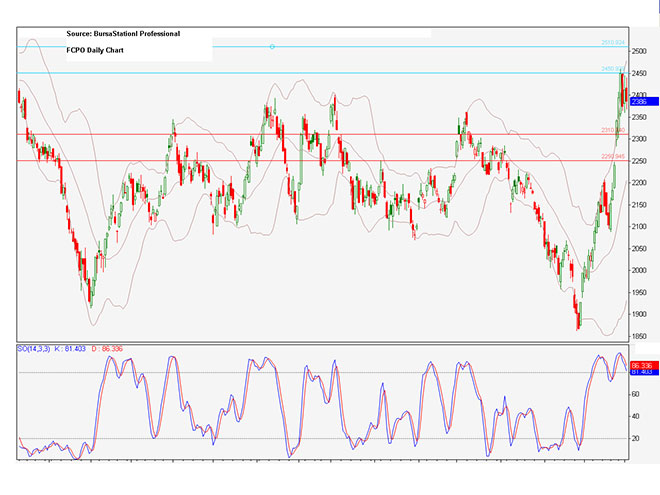 Malaysian palm oil futures edged lower on Friday to 2,386, due to investors’ profit taking before the weekend.
Malaysian palm oil futures edged lower on Friday to 2,386, due to investors’ profit taking before the weekend.
Future Crude Palm Oil (FCPO) benchmark December 2015 contract settled at 2,386 on Friday, up 44 points or 1.9 per cent from 2,342 last Friday.
Trading volume increased 184,286 to contracts from 158,833 contracts from last Monday to Wednesday.
Open interest based decreased to 568,411 contracts from 589,066 contracts from last Monday to Wednesday.
Intertek Testing Services (ITS) reported that exports of Malaysia’s palm oil products during September increased 0.5 per cent to 1.533 million tonnes compared with 1.525 million tonnes during August.
Societe Generale de Surveillance’s (SGS) report showed that Malaysia’s palm oil exports during September increased 0.7 per cent to 1.552 million tonnes compared with 1.542 million tonnes during August.
Overall, demand strengthened from India, while demand weakened from the EU, the US, China and Pakistan.
Spot ringgit was mostly changed on Friday to 4.41, before a US employment report that might bolster expectations of the Federal Reserve raising US interest rates this year, for the first time in almost a decade.
World palm oil output growth will likely slow down next year due to the El Nino weather pattern, said leading vegetable oil analyst Thomas Mielke on Monday, as some plantations in top producers Malaysia and Indonesia get affected by the event.
Crude palm oil (CPO) prices are likely to surge 40 per cent to US$700 per tonne by mid-2016 as an El Nino weather event dents output and as top producer Indonesia uses more palm-based biodiesel, said leading industry analyst James Fry.
An El Nino weather pattern is likely to slash Malaysia’s palm oil output by one million tonnes to 19 million tonnes in 2016, and boost prices to RM3,000 per tonne, chief executive officer of the Malaysian Palm Oil Council (MPOC) told Reuters.
Palm oil prices have bottomed out and will trade at RM2,100 to RM2,400 per tonne as a weaker Malaysian currency buoys demand, said leading vegetable oils analyst Dorab Mistry on Wednesday.
On Monday and Tuesday, the price rose for the sixth consecutive day, touching the highest in more than 15 months, as traders bet on increasing demand, lower supply, declines in the ringgit, and expectations recent dry weather and haze will curb crop output.
On Wednesday, the price fell for the first time in a week, rebounding from a 15 month high, while erasing the previous day gains, due to lower-than-expected export data and as traders booked profits after recent gains.
On Thursday, the price climbed for the seventh day out of eight sessions, recovering the previous day losses, as prices underpinned by expectations of lower production in October and forecasts of higher purchases by top consumer India.
On Friday, the price declined, as buyers started looking at alternatives such as soybean oil.
Technical analysis
According to the weekly FCPO chart, the price opened above the middle Bollinger band and psychological barrier at 2,300, while the SO entered overbought territory. By the end of the week, the price tested the top Bollinger band and psychological barrier at 2,400 closing below.
According to the daily FCPO chart, on Monday, the price opened below the top Bollinger band, and above the psychological barrier 2,300, while the SO remained in overbought territory.
A downside gap was formed from 2,340 to 2,320, which might be covered or indicate a potential to test the psychological barrier at 2,300 in the near term.
By the later session, the previous gap was covered, while the price tested the top Bollinger band, closing above, and testing the psychological barrier 2,400, closing below.
On Tuesday, the price opened below the top Bollinger band and resistance level at 2,390.
A downside gap was formed from 2,360 to 2,390, which might be covered in the near term or indicate the inability to break above the psychological barrier at 2,400.
By the later session, the price tested the top Bollinger band and resistance level at 2,450, closing above.
The previous gap was covered, while daily volume was above normal daily volume average.
On Wednesday, the price opened above the top Bollinger band and below the resistance level at 2,450. By the later session, the price tested the top Bollinger band and resistance level at 2,390, closing below.
On Thursday, the price opened below the top Bollinger band and resistance level at 2,390.
By the later session, the price tested the resistance level at 2,450, closing below, while the SO remained in overbought territory.
Daily volume was above the average daily volume.
On Friday, the price opened below the top Bollinger band and resistance level at 2,450.
By the later session, the price tested the resistance level at 2,390, closing below, while the SO exited overbought territory.
In the coming week, the price has potential to range between 2,300 and 2,450.
Resistance lines will be placed at 2,450 and 2,510, while support lines will be positioned at 2,310 and 2,250, these levels will be observed this week.
Major fundamental news this coming week
No upcoming fundamental news this coming week.
Oriental Pacific Futures (OPF) is a Trading Participant and Clearing Participant of Bursa Malaysia Derivatives. You may reach us at www.opf.com.my. Disclaimer: This article is written for general information only. The writers, publishers and OPF will not be held liable for any damage or trading losses that result from the use of this article.
